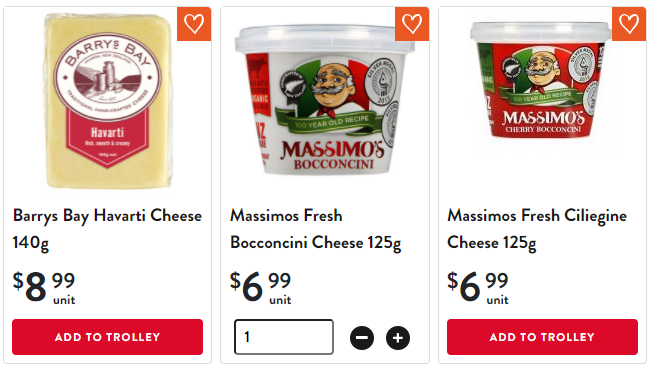So how do you make a great e-commerce basket?
Here are tips to help your customers navigate your shopping cart with ease.
1. Simple discounting
Show the discounted price and the standard price eg $5.00 was $6.00
2. Targeted pricing and discounting
Pricing and discounting that can vary by customer or vary by customer choices:
Location - for example the ability to have different prices and discounts per store
Customer - the ability to have different prices and discounts by customer - more common in B2B
Dates and times - variable pricing based on the date and/or time
Capacity - for example ticketing where the price changes based on the quantity remaining
3. Complex product discounts
A great e-commerce basket will support complex product discounts.
Product discounts generally work on the structure shown below:
Buy [quantity] of [product/product group]
Get [quantity] of [product/product group]
for [$, $ off, % off]
Product discounts can get extremely complex. Below are 5 examples of complex scenarios to check:
- On a '3 for $5 offer', how is the price applied to the individual products? 2 x $1.66 and 1 x $1.67?
- How do the discounts apply in downstream systems such as fulfilment?
- How are unavailable products handled in downstream systems such as fulfilment?
- On a '3 for $5 offer', how is the discount applied to the additional products? Does the 4th product receive a discount, or is it only applied in groups of 3? Is it configurable to allow for either of the previous options?
- Are tiered discounts possible? eg 1 for $10, 2 for $18, 3 for $24
4. Complex order discounts
A great e-commerce basket will support complex order discounts.
Order discounts generally work on the structure shown below:
Spend [$]
from [category/product group/entire order]
get [$, $ off, % off]
the [order/part of the order/delivery]
Combining order discounts with targeting can be an effective tactic to increase CLV.
5. Easy communication of complex pricing and discounting offers via products lists
Your ecommerce products and your ecommerce basket are closely related.
It's great to have a basket that supports complex offers, however you also need to ensure that your customers are aware of the offers.
Below is an example on how a complex offer can be well communicated:
- A customer performs a search, and amongst the search results, they are shown a product with an offer that states '3 for $5'.
- Clicking the '3 for $5' message allows the customer to view the full range of products that the 3 for $5 offer applies to.
6. Clear communication on the product whether the product is in the basket, or not in their basket
When a customer views a product, or a list of products, the customer should be able to easily see whether the product is in their basket, or not in their basket, and make adjustments to the quantity.
To achieve this, a standard design has arisen, as shown below.

Features of this design:
- the 'ADD TO TROLLEY' button (shown when the product is not in basket) should look quite different to the quantity input box and the '+' and '-' buttons that are shown when the product is in the basket.
- the quantity is the total quantity, not the quantity that you are adding or subtracting. If you're considering a different design, just don't.
- the text box allows large quantity changes to be done without requiring a lot of clicks.
If you're using a different design then:
i) Congratulations, you've invented a better wheel!
however it's more likely that
ii) Your new wheel may be square in some places
or
iii) Your product may have additional complexities where an alternate designs is required
- weighted products where switching between units and weight is helpful eg 3 chicken breasts vs 500 grams of chicken breast
- accounting for variances such as clothing sizes and colours
- baskets with products for multiple people eg tickets, food orders
7. Product requirements beyond quantity
Other than quantity the customer may want to communicate requirements like:
- Variant - size, colour etc
- Date eg tickets
- Person the product is for
- Ability to substitute
- Notes
- Gifting requirements eg different address, personal note, invoice not to be delivered
8. Options for product unavailability
Your ecommerce basket needs to have options on how to show unavailable products.
- i) The rules that determine when how an unavailable product should show eg show as unavailable when the current or future stock level is within a given range; show when the expected back in stock date is within a given range
- ii) How the product should show on the website eg show as unavailable with a reason, show as unavailable with an expected back in stock date, show as unavailable with the ability to back order
9. The ability to create a basket without signing in.
The core e-commerce customer journey solves your customers problems in order of priority from the greatest need to the lowest need.
This is generally something like:
-
Find the product(s) they are looking for
-
Add the product(s) to their basket / wishlist
-
View their basket / check out
-
Provide contact information / register
-
Pay
-
Log back in
Note that registration is the 4th step, not the 1st step. The top reason for the customer visiting your site was NOT to register. Registration is a barrier - barriers are bad as they lower conversion rates.
Anonymous orders do come with a complexity however. Consider the following scenario. You sign into a website and put some items in your basket. You revisit the website a few days later not signed in and put some items into a new basket as your previous basket can only be shown once you are logged in. You then sign in. How does the website treat your 2 baskets? 2 separate orders? Are they merged? Are you given the option to merge? How is it communicated to you that you have 2 baskets?
10. Useful options to sort and filter the basket
Sorting the basket by the items that were last added to the order, can help customers track the progress of their shop.
Sorting by category can also be useful for reviewing the order.
Sorting by supplier can be useful for sites where the delivery comes from multiple vendors.
11. Product quantity limits
Be able to control minimum and maximum quantities per order, or per customer over a time period.
12. Product Restrictions
The ability to restrict the display of products. For example, not showing liquor products when the customer is not of legal age.
13. Taxes
The ability to handle multiple tax rates at a product level.
14. Delivery and fulfilment fees
Show delivery and fulfilment fees that can vary by customer or customer choices, including the ability to apply discounts to these.
15. Helpful basket views options on wider screens
Option 1 - a basket that is viewable while shopping as a column on the right of the screen.
Option 2 - a total in the header, possibly also showing the last item added
Option 3 - a full screen basket view
Factor in the customers behaviour. Where the customer behaviour is to order multiple products, it can be helpful to have Option 1 of the basket showing while ordering.
16. Communication of changes in product information
Check how your e-commerce basket handles changes to the price and availability of a product.
What happens when a product in the basket changes price?
What happens when a product in the basket becomes unavailable?
17. Coupon functionality
Coupons help with tracking external promotions. They can also help with restricting targeted discounts, for example when you email a select group of customers a discount offer. If your promotion does not require either of these then you may want to question why you want to add the complexity of a coupon to the promotion.
18. Multiple Suppliers
Clearly group together products that will be fulfilled differently and clearly communicate fulfilment details such as estimated dates and times of delivery or collection.
19. Product bundling / kitting
Product bundling, or kitting, is when you combine multiple products together to be sold as one product. For example a gift basket.
Areas of complexity to check for:
- How are unavailable component products handled
- how are bundles found while browsing
- how are bundles found from searches on terms that match one or more of the component products.
20. The order can be amended after it is completed.
This is useful when your customers order large quantities on a regular basis. For example, after placing a grocery order at the start of a week and securing the delivery/collection time, it’s great for both the customer and the business that the customer can continually alter the order (usually adding for products) over the course of the week. This introduces complexities on how to handle changes in pricing and product availability.
21. Your site works well on all of the most popular devices and browsers
You’ll need responsive design to give a great experience on all screen sizes. You will also need a solution that works on the most popular combinations of devices and browsers. In particular pay attention to mobile devices like smart phones and smart phones with the smallest screen sizes.
22. The shopping experience is fast for all functions, on all devices, and on all networks
Fast is ¼ of a second for all actions. Longer response times are acceptable for some initial loading, however this must be well communicated. The network can be a weak link for speed, so having parts of your application work offline (also known as client side) is a good solution to minimise response times.
Make sure you test under the following conditions:
-
Maximum load conditions (eg hundreds or thousands of people using the application at the same time)
-
On a poor network eg rural low bandwidth or something that replicates that
-
On older, low performance devices
Note: 21 and 22 are last in the list but are 2 of the most important to get right. Technically these are known as non-functional requirements. Make sure these are a focus from the start and remain high priority.

About Norm Achibald, Senior Trader Product Lead.
In 2009, I was extremely fortunate to accelerate my e-commerce learning with Olympic Software and Countdown Supermarkets, who at that time had been leading the market for over a decade.
From 2009 to 2017 we continued to grow the market with the introduction of new features like mobile sites, and 'click and collect' - it's hard to believe now that these once didn't exist.
In 2017 I moved to Bidfood and continued to learn more on the nuances of food and drink e-commerce for B2B.
Ange and I live in Morningside, and when I'm not obsessing on how 👪people, 📐design, and 🚀technology can combine to improve e-commerce, then you'll likely find me acting as an uber-like driving service for teenage children, and working out how to best fit a game of squash, and at least one hot yoga session, into my weekly schedule.
My role at Olympic is the Product Owner for an extremely empowering enterprise ecommerce platform known as Trader.
Working with Trader in FMCG, I was able to attain growth milestones of $1m per week, followed by $1m per day, and upwards again from there.
The quality of the platform gave me the confidence to continually set, and achieve, higher growth targets for sales, margin and customer satisfaction.
The platform was adopted by the Australian retail giants of Woolworths and Dan Murphys in 2013 and 2016 where it achieved even greater scale and sales volume levels.
Trader offers:
🛒 A basket that supports complex, targeted, pricing and discounting.
🎯 A content management system that provides powerful options for personalised and targeted communication.
📈 A team that quickly understands your business with a focus on maximising your e-commerce opportunities.
🔗 A pragmatic approach to integrating with internal and 3rd party systems to provide a complete e-commerce ecosystem covering essential areas such as customer service, order fulfilment, delivery, email marketing, loyalty, rewards, SEO, SEM, analytics and business insights.
Once established, Trader often meets new business requests without the need for additional development, making an extremely empowering enterprise ecommerce platform.
